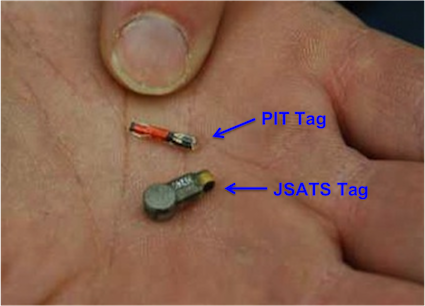Monday January 11, 2010

A new, super-small (0.43 gram) acoustic tag designed to track juvenile salmon around hydroelectric dams on the Columbia River is challenging Passive Integrated Transponder (PIT) tags. According to a new paper published in the AFS journal Fisheries, the new Juvenile Salmon Acoustic Telemetry System (JSATS) can evaluate juvenile salmon migration more accurately than PIT tag systems, using 1/10 as many fish.
The Fisheries paper suggests that the JSATS system is advantageous to PIT tags since higher detection rates means less fish need to be tagged, and acoustic receivers can be placed in more locations in rivers and around hydroelectric facilities. By contrast, PIT tag antennas have to be constructed in fish bypass sytems and significantly more fish need to be tagged and released.
Perhaps the greatest advantage of JSATS is the non-proprietary nature of the technology, meaning anyone can manufacture or sell the equipment. The Pacific Northwest National Laboratory and NOAA Fisheries have been developing the salmon tracking system since 2001. More JSATS information is available at the Pacific Northwest National Laboratory.
REFERENCE: G.A. McMichael, M.B. Eppard, T.J. Carlson, J.A. Carter, B.D. Ebberts, R.S. Brown, M. Weiland, G.R. Ploskey, R.A. Harnish and Z.D. Deng. “The Juvenile Salmon Acoustic Telemetry System: A New Tool.” Fisheries, Vol. 35, No. 1, January 2010.
Photo source: Tri-City Herald
